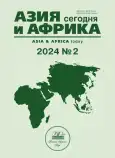Индия идет в Южно-Китайское море
- Авторы: Муратшина К.Г1
-
Учреждения:
- Институт востоковедения РАН
- Выпуск: № 2 (2024)
- Страницы: 5-14
- Раздел: Политика, экономика
- URL: https://journals.rcsi.science/0321-5075/article/view/256331
- DOI: https://doi.org/10.31857/S032150750030070-9
- ID: 256331
Цитировать
Полный текст
Аннотация
Ключевые слова
Об авторах
К. Г Муратшина
Институт востоковедения РАН
Email: k.muratshina@ivran.ru
ORCID iD: 0000-0001-7952-6299
кандидат исторических наук, старший научный сотрудник Центра Юго-Восточной Азии, Австралии и Океании Москва, Россия
Список литературы
- Patil S. The importance of India’s defence partnership with Vietnam. 28.06.2022. https://www.orfonline.org/expertspeak/the-importance-of-indias-defence-partnership-with-vietnam/ (accessed 07.06.2023)
- Parameswaran P. What’s next for India–Philippines defense cooperation? 20.11.2017. https://thediplomat.com/2017/11/whats-next-for-india-philippines-defense-cooperation/ (accessed 20.01.2023)
- Saha Р. How India’s BrahMos deal is not just about Philippines but gives a stronger message to the region. 12.02.2022. https://orfonline.org/research/how-indias-brahmos-deal-is-not-just-about-philippines/ (accessed 19.10.2022)
- Bhattacharjee D. India and Brunei: а brief overview. 18.06.2018. https://www.icwa.in/show_content.php?lang=1&level=3&ls_id=2418&lid=1821 (accessed 17.01.2023)
- Южно-Китайское море: современные вызовы и угрозы. Отв. ред. и сост. Е.М.Астафьева. М.: ИВ РАН, 2020. 390 с.
- Sharma B., Sinha U.K. Understanding China–Russia cooperation in the Arctic. 10.01.2023. https://idsa.in/issuebrief/understanding-china-russia-cooperation-bsharma-uksinha-100123 (accessed 19.01.2023)
- Chinoy S.R. Inaugural address on deciphering China – the maritime context. 26.11.2020. https://www.idsa.in/keyspeeches/inaugural-address-by-sr-chinoy-icsb-c3s-pii (accessed 19.01.2023)
- Anand S. China’s maritime intent in South China Sea vis-à-vis ASEAN. 23.06.2009. https://www.idsa.in/idsastrategiccomments/ChinasMaritimeIntentinSouthChinaSeaVisaVisASEAN_SAnand_230609 (accessed 19.01.2023)
- Singh A.K. China’s creeping maritime assertiveness. 03.01.2017. https://www.idsa.in/issuebrief/china-creeping-maritimeassertiveness_aksingh_030117 (accessed 19.01.2023)
- Dwivedi G. China’s quest for world dominance & its impact on India and the region. 01.11.2021. https://indiafoundation.in/articles-and-commentaries/chinas-quest-for-world-dominance-its-impact-on-india-and-the-region/ (accessed 13.01.2023)
- Bhatia R. Assessing the 35th ASEAN summit – analysis. 29.11.2019. https://www.eurasiareview.com/29112019-assessing-the-35th-asean-summit-analysis/ (accessed 13.01.2023)
- Das R.N. Chinese and American muscle-flexing in South China Sea: implications for India. 19.08.2010. https://www.idsa.in/idsacomments/ChineseandAmericanMuscleflexinginSouthChinaSeaImplicationsforIndia_rndas_190810 (accessed 19.01.2023)
- Mishra R. China’s land reclamation in the South China Sea: implications for the region. 16.06.2015. https://www.icwa.in/show_content.php?lang=1&level=3&ls_id=656&lid=598 (accessed 17.01.2023)
- Pukhrem S. From Look East to Act East: enhancing India–ASEAN integration. 13.08.2017. https://indiafoundation.in/articles-and-commentaries/from-look-east-to-act-east-enhancing-india-asean-integration/ (accessed 14.01.2023)
- Bajpai B.А. China crossing all limits in South China Sea. 25.01.2021. https://www.indiandefensenews.in/ 2021/01/china-crossing-all-limits-in-south.html (accessed 13.01.2023)
- Kapoor N. Russia’s conduct in the South China Sea. 18.06.2021. https://www.orfonline.org/research/russias-conductin-the-south-china-sea/ (accessed 14.01.2023)
- Singh А. Why India’s South China Sea stand matters. 19.08.2016. https://www.idsa.in/idsacomments/why-indiasouth-china-sea-stand-matters_asingh_190816 (accessed 19.01.2023)
- Pant H.V. The strategic signal of an Indian presence in the South China Sea. 02.09.2021. https://www.orfonline.org/research/strategic-signal-indian-presence-south-china-sea/ (accessed 14.01.2023)
- Panda J. India’s ‘multipolar Asia’ and China. 27.08.2019. https://www.eastasiaforum.org/2019/08/27/indias-multipolar-asia-and-china/ (accessed 17.12.2022)
- Singh A.K. Suryakant Prakash Nikam asked: What is the relevance of Spykman’s rimland model in the context of the ongoing South China Sea conflict? 18.11.2016. https://www.idsa.in/askanexpert/spykman-rimland-south-china-seaconflict (accessed 19.01.2023)
- Kalha R.S. India and the South China Sea. 29.09.2011. https://thediplomat.com/2011/09/india-and-the-south-chinasea/ (accessed 15.01.2023)
- Aggarwal S. India’s China policy: dynamics of ‘change’ and ‘continuity’. 13.05.2019. https://indiafoundation.in/articles-and-commentaries/indias-china-policy-dynamics-of-change-and-continuity/ (accessed 14.01.2023)
- Gokhale V. How the South China Sea situation plays out will be critical for India’s security. 16.06.2020. https://indianexpress.com/article/opinion/columns/south-china-sea-dispute-asean-countries-relations-vijay-gokhale-6460680/ (accessed 13.01.2023)
- Modi N. ASEAN–India: shared values, common destiny. 26.01.2018. https://vietnamnews.vn/opinion/421836/aseanindia-shared-values-common-destiny.html (accessed 14.01.2023)
- The India–Myanmar–Thailand trilateral highway and its possible eastward extension to Lao PDR, Cambodia and Vietnam: challenges and opportunities. ERIA Research Project Report. 2020. № 02a. 278 р.
- India–ASEAN defence relations. Ed. by A.K.Das. Singapore: S.Rajaratnam School of International Studies, 2013. 332 p.
- Singh M. China consolidates claim in South China Sea. 17.04.2013. https://www.idsa.in/idsacomments/ChinaconsolidatesclaiminSouthChinaSea_msingh_170413 (accessed 19.01.2023)
- Chellaney B. India’s Shinzo Abe. 16.05.2014. https://project-syndicate.org/commentary/brahma-chellaney-assesses-thelikely-impact-of-narendra-modi-s-victory-on-his-country-s-economic-and-foreign-policies (accessed 30.11.2020)
- Куприянов А.В. Инициативы SAGAR (Security and Growth for All in the Region) и IPOI (Indo-Pacific Oceans Initiative): формирование сферы безопасности Индии через региональное развитие. Сравнительная политика. 2021. № 4, c. 68–81. doi: 10.24411/2221-3279-2021-10041
- Юрлов Ф.Н. Индия. Внешняя политика правительства Н.Моди. Основные направления и проблемы. Азия и Африка сегодня. 2015. № 11. С. 25–30.
- Усов В.А. От «Энтерпрайза» до «Нимица»: эволюция индийско-американских отношений и новые вызовы. Проблемы национальной стратегии. 2021. № 3, c. 123–143. doi: 10.52311/2079-3359_2021_3_123
- Пахомов Е. Четверка QUAD – азиатское НАТО? Взгляд из Индии. 28.09.2021. https://tass.ru/opinions/12522035 (accessed 16.01.2023)
Дополнительные файлы











